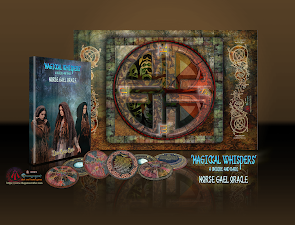There are no clear examples of rune staves carved
for divinatory purposes, which is most likely since they were scratched on
perishable materials. They were also possibly ritually destroyed after usage as
a matter of course. It is another odd fact that there is no direct, historical
reference to the act of rune casting in Old Norse literature. Despite all of
this, which is chiefly based on indirect linguistic evidence and parallel
accounts in historical texts, we can be certain that the practice is known.
Linguistic evidence comes in two forms: words for rune casting tools and terms
that must have originally been characterizations of rune casting results.
Veistu hvé fá skal? (Do you know how to colour?).
"Fá" means to draw or paint. It is the process of
coloring or staining runes after they have been carved. Red, blue, yellow,
white, and black traces have been discovered on stone. Red ochre, white lead,
red lead, and soot were the most frequent pigments. The wooden runes were
probably colored as well. It is widely accepted that sacrifice blood was used
to redden wooden runes to impart life power to the artefact.
This is how Egill Skallagrimsson performs rune magic
in Egilssaga. In Grettissaga, too, the runes are
stained with blood to effect magic. Actual pieces of wood on which individual
runes or runic combinations were carved (and usually colored with blood or red
dye) were known in Old Norse as hlaut-teinar (sg., hlaut-teinn; lot twig) (also
known by Snorri Struluson as blood twigs), and hlaut-vidhar (lot woods).
The fact that runes were carved on pieces of wood that
were most likely employed in divinatory rites may have contributed to the
initial use of the Germanic name "stabaz" (stave, stick). The terms
"nino" and "stabaz" grew so entwined because of this
practice that they became equivalent. The Old English phrase
"wyrd-suef" (stave ofwyrd or odd), an evident reference to divinatory
use, provides an interesting piece of confirming evidence.
As far as the actual practice of rune casting is
concerned, the best description i
s provided by Tacitus writing in chapter 10 of
Germania (ca.98 C.E.). Formerly, there might have been a debate as to whether
the notae (signs) mentioned by him could have been runes because the oldest
inscription was thought to date from about 150 C.E. But with the discovery of
the Meldorf brooch (ca. 50 C.E.), from the west coast of Jutland, we now have
hard evidence that the runes were known from before the time of Germania.
Its discovery at Roskilde seemed appropriate,
given the antiquity of the city, going back to the sixth century AD, and its
relative proximity to the Jutland Peninsula where Denmark joins Germany. It was
here that the mid-first Century AD Meldorf brooch, the earliest known artifact
with runic writing, was found. What made the Roskilde staff—older than the
proud long-ship by at least five hundred years—particularly interesting was its
identification of the Norsemen’s runes with their gods.

AVAILABLE NOW IN PRINT at "TheGameCrafter.com"
Place an ONLINE ORDER on its
OFFICIAL SITE at
"THEGAMECRAFTER"












No comments:
Post a Comment